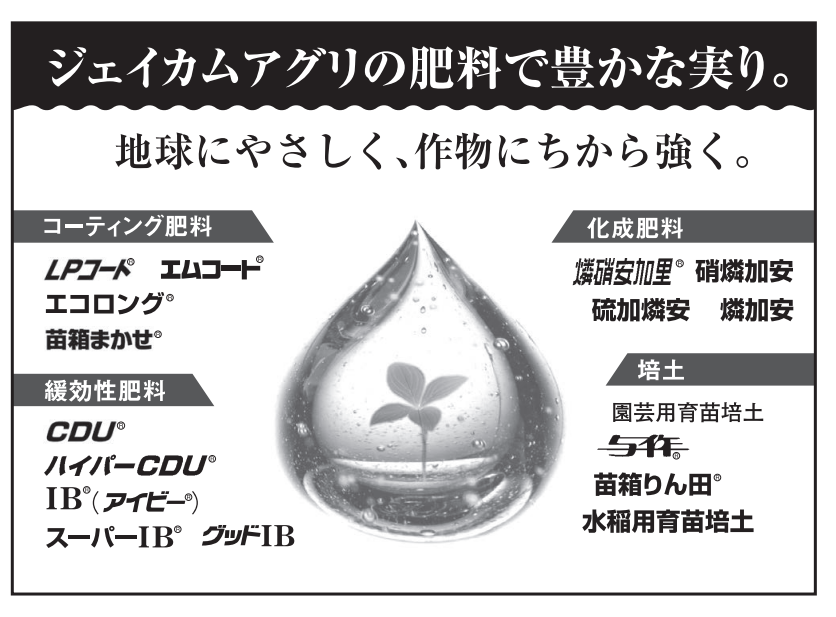

Site Search
Search within product
No.713 Published 2019 (R1) .08/09
Click here for PDF version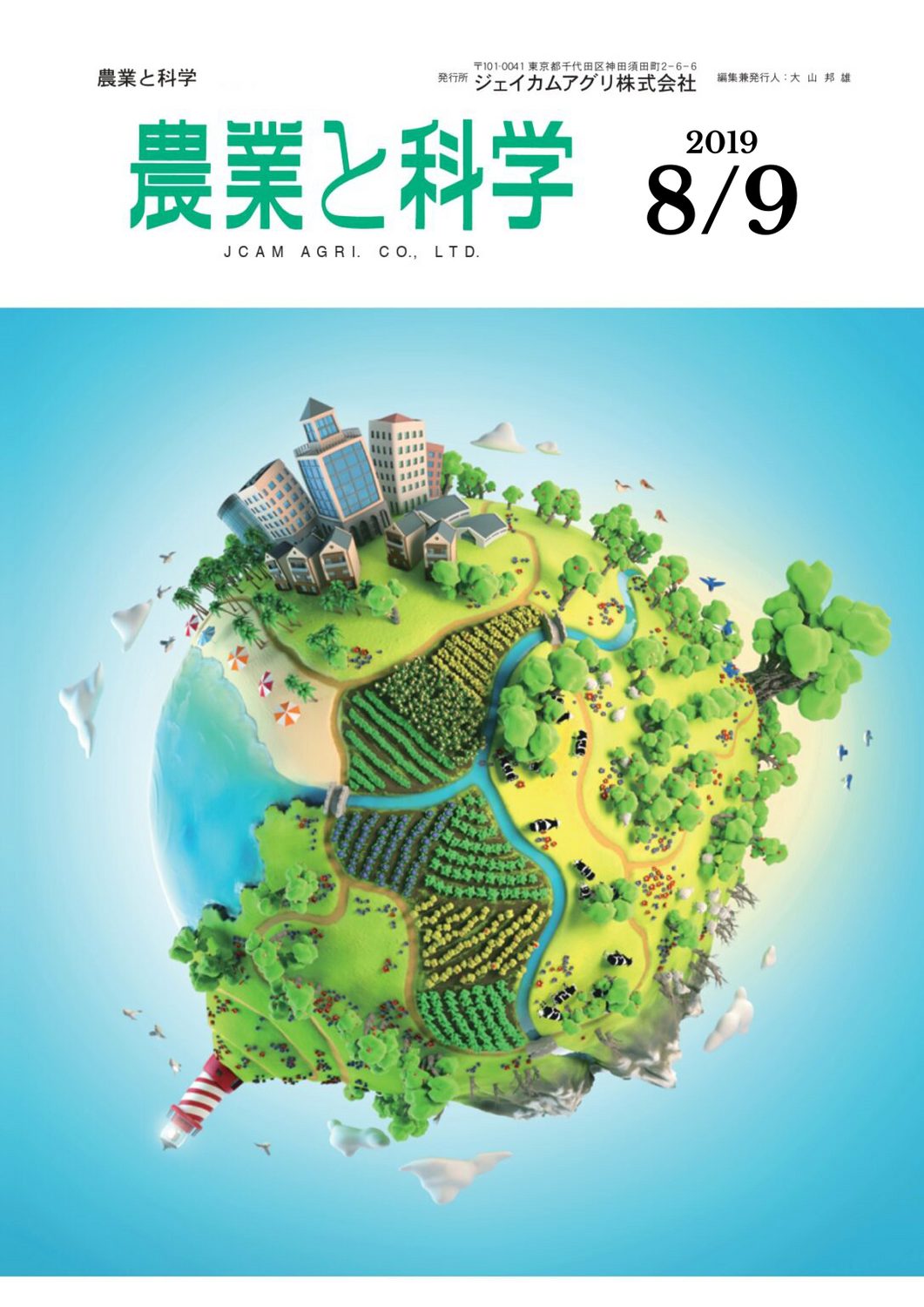
Agriculture and Science 09/08/2019


Time and duration of flooding as well as after flooding
Effect of liquid fertilizer injection treatment on growth and yield of lettuce
Hyogo Prefectural Agriculture, Forestry and Fisheries Technology Center
Awaji Agricultural Technology Center, Agriculture Department
主任研究員 中 野 伸 一
Introduction
In the cultivation of open field vegetables, heavy rainfall is a major factor that destabilizes the crop. In particular, it has been reported that in summer and fall plantings, the growing period often coincides with typhoons and long rains, resulting in catastrophic damage, a sharp decrease in shipping volume, and a sharp rise in prices, causing confusion in the market and problems.
In Hyogo Prefecture, damage to agricultural products caused by Typhoon No. 23 in October 2004 amounted to 3.2 billion yen, most of which was due to flooding of open-air vegetables after planting, resulting in damage of 1,028 ha and 2.75 billion yen. In addition to typhoons, the number of localized heavy rains, which are short duration heavy rains of 50 mm or more per hour, has been increasing over the past 40 years, and open field vegetables are more likely to encounter flooding damage.
Lettuce is widely cultivated in open fields from autumn to spring in this prefecture, taking advantage of the mild winter climate. When such fields are flooded, it is necessary to predict the degree of decrease in growth and yield after flooding depending on the timing and extent of flooding, and to determine whether or not cultivation should be continued.
In this study, we conducted an experiment in which lettuce cultivated in planters were submerged in water to reproduce temporary flooding during the lettuce growing season, and evaluated 1) the effects of the timing and duration of flooding on subsequent growth, yield, and merchantability. The effects of 1) the time and duration of flooding on subsequent growth, yield, and merchantability were evaluated. 2) As a countermeasure after flooding, a urea drenching treatment was investigated to restore the vigor of the grass. It has been reported that urea is non-electrolyte, has a small molecular weight and extremely high diffusion and permeability, and that it easily penetrates through the cuticular layer of the leaf epidermis and enters the leaf interior.
2. Testing Method
Experiment 1: Effect of timing and duration of flooding on subsequent growth and yield
The experiment was conducted in a field at the Awaji Agricultural Technology Center in Yagiyogichu, Minami-Awaji City, Hyogo Prefecture. The test variety was 'Humming Chau' (Japan Agri-Science Co., Ltd.), an early maturing conventional variety with a high risk of flooding damage. -On September 14, two plants were planted in a planter of 650 mm long, 240 mm wide, and 180 mm deep. The planters were filled with field soil (fine yellow soil and clay loam) and fertilizer was applied at a rate of 0.8:0.6:0.6:0.6 kg-a-1 N:P2O5:K2O using a chemical fertilizer as base fertilizer. Flooding treatments were applied to the in-field plots with
The entire plant was submerged in a hole (5 m long, 2 m wide, and 1 m deep) filled with water.
(Figure 1).
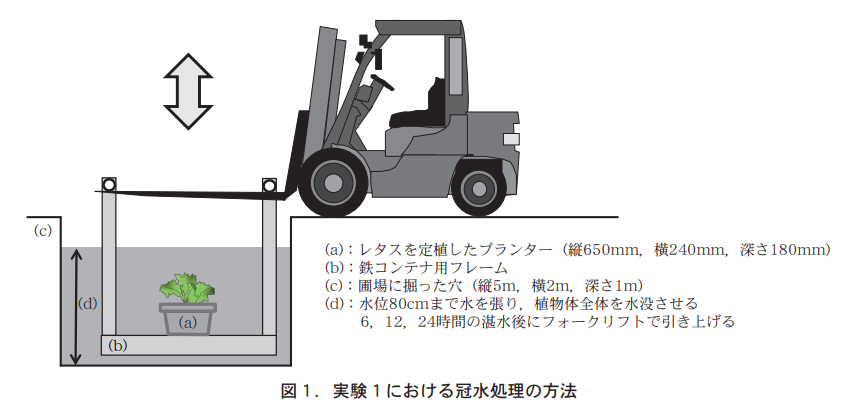
The plants were flooded at four growth stages: post-emergence (September 24: 10 days after planting, leaf age: 9), pre-pollination (October 4: 20 days after planting, leaf age: 13), early pollination (October 14: 30 days after planting, leaf age: 18), and pre-harvest (November 7: 54 days after planting, leaf age: 35). The three stages were flooded for 6, 12, and 24 hours.
Harvesting was conducted on November 22, and the following data were obtained: total above-ground weight, number of outer leaves, maximum outer leaf length, maximum outer leaf width, tuber weight, number of tuber inner leaves, core length (length from the tip of the tuber to the bottom of the tuber), core weight (weight of the tuber part from which tuber inner leaves were removed), percentage of dead plants, percentage of non-bulked plants (Σ (index x number of plants)/(total number of plants x 3)) x 100), and the degree of mud covering (index 0 (no mud covering), index 1 (mud covering 1-2 inner leaves), index 2 (mud covering 3-5 inner leaves), and index 3 (mud covering 6 or more inner leaves), based on the number of inner leaves with mud covering). The effects of flooding treatment on growth, yield, and merchantability were evaluated by comparing Irrigation
Water was applied as needed with hose irrigation.
Experiment 2: Effect of urea drench treatment after waterlogging on growth and yield of lettuce
The seedlings were sown in 200-hole cell trays on August 21, 2013, and planted on September 13, 2013. Row width was 130 cm, row spacing was 30 cm, and fertilizer application was the same as in Experiment 1. Based on the results of Experiment 1, the water level was raised until the water level was about 3 cm above the surface of the ridges, and then the water was removed after 6 hours. The waterlogging treatments were conducted on the day of an approaching typhoon, assuming actual damage, and were conducted during two heavy fall rains: 26 days after planting before lettuce tuberization (October 9, 2013, when typhoon No. 24 approached, with leaf age of about 16) and 33 days after planting in the early tuberization stage (October 16, 2013, when typhoon No. 26 approached, with leaf age of about 18). On October 17, after the waterlogging treatment, the rows in the waterlogged and non-flooded treatments were
Nine soil samples were taken at a depth of 5 to 15 cm from the surface, and EC was measured.
On the day after waterlogging, 50 L a-1 of urea solution was applied at the base of the plants as a follow-up measure. The urea was applied from the top of the lettuce to the base of the plants using a power sprayer equipped with a nozzle that sprayed water in a shower-like pattern. Urea was used here because urea has the highest absorption efficiency among nitrogen monofertilizers, is readily available, has high solubility in water, and is easy to prepare as a liquid fertilizer, making it an easy-to-use solution after waterlogging. Urea has been reported as a measure to reduce moisture damage in soybean and other crops through foliar sprays1), 2) .
However, foliar spraying has a limited amount of spray per application, and the number of applications increases. The urea liquid fertilizer was applied at a factor of 50, which was the most effective, based on the results of preliminary tests conducted at three levels (25, 50, and 100 times). The application rate was 0.4 kg a-1, which corresponds to the amount of nitrogen required for one additional fertilizer application in conventional lettuce cultivation.
Harvesting was conducted on November 1, and the following data were collected: total above-ground weight, tuber weight, sphere shape index, sphere area, tuber turgor, saleable sphere percentage, yield, standards (four grades: 2L (~165 mm), L (165 to 150 mm), M (150 to 135 mm), and S (135 mm and up) based on sphere diameter), and grade (sphere distortion, rise, and protrusion of midrib were evaluated on a scale of 0 to 2). The results were compared with those of the following three grades: excellent (total index of 0 to 1 and tuberosity of 0.25 to 0.35), superior (total index of 2 to 3), and A (total index of 4 to 6). The plants were irrigated with a hose using a power sprayer once immediately after planting, and no irrigation was applied thereafter. The survey was conducted in four replications of 10 plants per plot. Yield was calculated from 50 consecutive plants in each plot.
Results and Discussion
Experiment 1: Effect of timing and duration of flooding on subsequent growth and yield
Table 1 shows the effects of growth time and duration of flooding on lettuce growth and yield during the flooding treatment. Lettuce plants were greatly affected by flooding in the first half of the growth stage, after emergence and before tuberization, resulting in smaller tuber weight, core length, and core weight, and all plants died, especially in the 24-hour flooded area. On the other hand, there were no non-bulking plants in the non-flooded area. The effect of flooding on the initial stage of tuberization and the later stages of growth before harvest became smaller, but the longer the flooding time, the smaller the tuber weight compared to the non-flooded area. In the pre-harvest flooding, mud biting occurred regardless of the duration of flooding, and mud adhered to the outer fifth of the inner leaves of the tuber.

In the evaluation of the effect of flooding in planter cultivation, the non-treated area showed sufficient growth with a tuber weight of more than 500 g at harvest, and it was thought that this experimental method could be used to evaluate yield. Regarding the effect of time and duration of flooding, the 6-hour and 12-hour flooding treatments had a greater effect on the reduction of tuber weight in the first half of the lettuce growth stage (leaf age of about 13), which is after the plants are fully grown and before tuberization.
Lettuce generally tends to have a large and early growth response to nitrogen conditions, and it is said that the fertilizer application response appears by the beginning of tuberization at the latest in terms of growth stage, and that cultivation management up to the beginning of tuberization is important for controlling lettuce growth3) . In addition, the outer leaf of lettuce has two roles: (1) maintenance of the tuberous body and (2) enlargement and enrichment of the bulb, and it is said that the formation of the outer leaf is important for the subsequent enlargement of the bulb4) . In this experiment, the decrease in tuber weight due to flooding in the first half of growth is considered to be due to the fact that fertilizer components could not be absorbed sufficiently during the period of outer leaf formation and the beginning of tuberization due to flooding, and thus outer leaves were not formed.
Next, as for the effect of flooding time in the second half of growth (after leaf age 18), there was no significant difference in tuber weight between the 6- and 12-hour flooded areas in the early stage of tuberization (leaf age 18) and the 6-hour flooded area before harvest (leaf age 35), but the 24-hour flooded area in the early stage of tuberization with a longer flooding time and the 12- and 24-hour flooded areas before harvest had significantly lighter tuber weight than the untreated area. However, the 24-hour flooded area during the early stage of setting and the 12- and 24-hour flooded areas prior to harvest had significantly lower tuber weights. This may be due to the fact that the longer the flooding time, the longer the hypoxic condition in the root zone, the lower the root function, and the lower the nutrient absorption.
The effect of mud on the degree of mud penetration into the tuber was not significant, since the degree of mud penetration was 94 or higher when the crop was flooded before harvest regardless of the flooding time, whereas the degree of mud penetration was 17 or lower when the crop was flooded in the early tuber stage.
Experiment 2: Effect of urea drench treatment after waterlogging on growth and yield of lettuce
Table 2 shows the effects of urea drench treatment after waterlogging on lettuce growth and yield. Compared to the non-treated area, total above-ground weight, tuber weight, and tuber area were significantly lower in the waterlogged area, and yield was also lower at 149 kg-a-1.

On the other hand, the total above-ground weight, tuber weight, and sphere area of the waterlogged + urea plots were significantly greater than those of the waterlogged treatment at 201 TP3T, 121 TP3T, and 331 TP3T, respectively. Soil EC was measured on October 17 immediately after the waterlogging treatment and was 0.23 mS-cm-1
The value was 0.21 mS-cm-1 in the non-treated area.
The effect of urea drench treatment after waterlogging on lettuce quality is shown in Table 3. The percentage of L or larger bulbs in the waterlogged + urea treatment (48%) was greater than that in the waterlogged treatment (8%), indicating that the bulking ability of the bulbs was recovered. The percentage of superior quality was 121 TP3T in the waterlogged + urea area, compared to 81 TP3T in the waterlogged area.
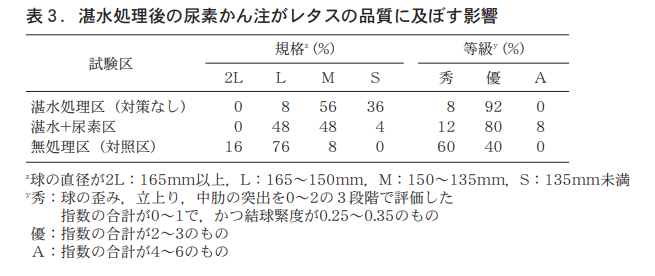
Based on the results of the planter cultivation in Experiment 1, it is considered necessary to supplement fertilizer components to further recover yield, although noncuberization does not occur if the plants are inundated for up to 12 hours during the first half of the growing season (leaf age: about 13). Therefore, in Experiment 2, we examined the effect of urea drench treatment on yield recovery.
In Experiment 2, the tuber weight and yield decreased in the waterlogged area, but recovered to the same level in the waterlogged + urea area as in the non-treated area. This is thought to be due to the fact that the injections of urea liquid fertilizer, which can be absorbed from both underground and aboveground sites, compensated for the lack of nitrogen absorption caused by the waterlogging treatment, and the vigor of the grass was restored.
The EC of the soil after the waterlogging treatment did not decrease enough to indicate that soil nutrients were washed away by the waterlogging treatment, and it is unlikely that the effect of urea fertilizer application was strongly affected by soil nutrient loss. Although some plants showed symptoms of fertilizer burn on the outer leaves immediately after urea application, no such symptoms were observed on the tuber at harvest, and no brownish tips were observed on the inner leaves of the tuber when the tuber was disassembled. In the urea and waterlogging treatments, the growth of the tubers recovered, but the shape of the tubers was unstable, and the percentage of superiority was lower than in the non-treated treatments. It is assumed that the growth was suppressed by waterlogging, and that the subsequent fertilization by urea injection resulted in rapid ball enlargement, which disrupted the ball shape and reduced the percentage of superior products. Further study is needed to determine the amount of fertilizer applied to minimize the disturbance of ball shape.
Summary
The results of Experiments 1 and 2 indicate that lettuce can survive up to 12 hours of waterlogging at the growth stage before tuberization (leaf age 13 to 16), and that yield recovery is possible with urea drench treatment. These results suggest that the growth stage and duration of waterlogging of lettuce can be used in production as a criterion to determine whether to replant or not.
References
1)水田転換畑におけるダイズの過湿障害 第3報
尿素の葉面散布による湿害の軽減.
杉本秀樹・ 佐藤亨・西原定照・成松克史.日作紀.58:605−610.1989.
2)Uptake of mineral nutrients from foliar fertilization (Review).
Wójcik, P. J. Fruit Ornam. Plant Res. Special ed. 12:201−218.2004.
3)球肥大充実の生理.
加藤徹.農業技術大系野菜編6.レタス サラダナ.p. 基49−58.農文協.東京.1972.
4)レタスの形態と栄養生理.
塚田元尚.農業技術大系土壌施肥編2.p.113−119.農文協.東京.1987.
The problem of thatch happening on the golf course and
Lawn Thatch Decomposition Effectiveness Test of Fertilizer with CDU
General Incorporated Foundation Kansai Green Research Institute
所 長 森 将 人
1. thatch problem on golf courses
Golf courses are maintained with a single vegetation called turfgrass, and the most extensive areas are roughs and fairways. Although turfgrass species vary from region to region, in the Kansai region, Japanese knapweed is mainly used for the roughs, and Japanese korai shiba for the fairways. Since both are Japanese turfgrasses, their stems and leaves "wither" during the winter, and the dead stems and leaves are deposited on the soil surface.
Failures that are likely to occur when thatch accumulates include reduced turfgrass activity, fertilizer and water infiltration disturbance, reduced herbicide effectiveness, and high incidence of large patch disease in areas prone to poor drainage and excessive humidity. Earthworm infestations are also more likely to occur in areas prone to excessive humidity. Earthworms are generally considered to be beneficial insects that promote soil composite structure. However, earthworm infestation on golf courses is not very desirable because large numbers of earthworms can lead to the formation of large mounds of feces, which can affect golf play and the appearance of the golf course. In addition, the areas where earthworms occur are often prone to poor drainage, but it is not clear whether earthworms increase in areas with poor drainage or whether the increase in earthworms causes poor drainage.
2. lawn death due to soil acidification
Next, as a problem caused by the increase in thatch, we will introduce a new case of thatch on a golf course. Although the area affected and the degree of damage vary from region to region, yellowing and death of Japanese grass in the roughs and fairways of golf courses has been observed from May to June (Photo 1).
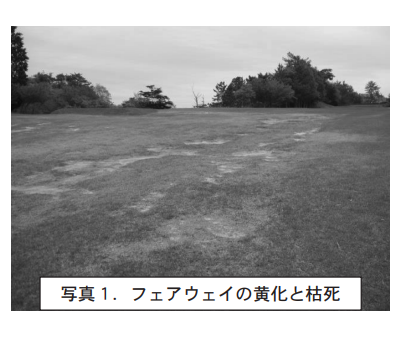
The initial symptom is irregular yellowing of both Japanese knapweed and Japanese korai shiba. Yellowing tends to occur between April and the onset of the rainy season, and often occurs in the same location every year. Several years after the onset of yellowing, the density of turfgrass clearly decreases, no new shoots appear in spring, and the turf continues to die even in summer, when it is most active in growth. Even if fertilizer is applied, the symptoms do not recover and the area of dead areas increases.
In some cases, it is not uncommon for lawns to yellow or die, and possible causes include (1) insufficient fertilizer, (2) feeding damage by lawn diseases or insects, (3) the effects of herbicides used in the fall and spring, and (4) tread pressure caused by players or maintenance equipment stepping on the turf. Although the causes can be assumed to some extent according to turf management records and the use of chemicals and fertilizers, in the golf course in the photo, the causes were different from those listed above, and the main factor was soil acidification.
(1) Causes of soil acidification
The cause of soil acidification may include mountain soils that are acidic, and tea is often grown in areas with acidic soils. The pH suitable for tea cultivation is said to be around 4.0 to 5.0, and in the Kansai region, yellowing is most likely to occur on golf courses in Kyoto and Nara prefectures. In addition, the acidification of the soil due to the accumulation of thatch on golf courses may have an effect on the growth of lawn grass.
(2) pH of dead turf area
The condition of a golf course where the turf field has died appears at first glance to be that the turf has completely died and the soil on the ground surface is bare, but organic matter such as dead turf and thatch has accumulated in the surface layer to 2 cm to 4 cm in depth (Photo 2). The dead areas are uniformly in the same condition, and digging into the surface layer reveals an accumulation of organic matter such as peat moss, which would not be present if the lawn had simply died. This is probably due to the accumulation of lawn clippings and winter dead material over the years.
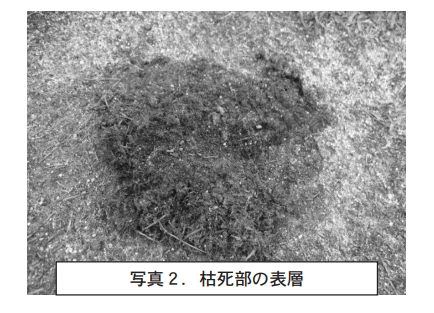
The pH of the dead area was measured to be pH 3.2 to 3.7 in the surface area with high organic matter and pH 4.0 to 4.7 in the soil below the organic matter, indicating that the soil is clearly acidic. The pH of soil suitable for turfgrass is basically neutral, ranging from pH 6.0 to 7.0, although there are some differences depending on the turf species.
(3) Methods of improving acidic soil
Even on a golf course with acid soil, it is unlikely that a turf that was green until a few years ago will suddenly die out. If acidic soil was originally the cause, problems such as the turf not establishing itself would have occurred within a few years after the turf was installed at the time the golf course was built. If there is no problem after the construction of the golf course, the yellowing and death of the turf after 20 or 30 years are caused by the accumulation of thatch over many years.
Until around 1980-1990, when the golf boom was in full swing, management budgets were available, and fairways were renewed by vertical grading and sanding once or twice a year. These operations were greatly related to the accumulation of thatch, but after 2000, management budgets tended to be reduced, and the balance that had been maintained for adequate removal and decomposition of thatch by renewal operations was lost, and the soil became acidic due to the accumulation of thatch.
In an attempt to bring acidic soil as close to neutral as possible, we treated it with bitter lime. The purpose was to neutralize the soil by adding an alkaline material to an acidic soil. The amount of bitter lime applied was assumed to be 20 to 100 grams per square meter, but since the application was made in late April, 20 grams was applied in consideration of the effect on the lawn. In winter, 50 to 100 g would be acceptable, but during the growing season, symptoms such as withering of the tips of the leaves would appear.
Soil pH was measured from 0 to 3 cm of surface soil and 3 to 5 cm of subsoil. Compared to the pre-treatment pH, the soil pH was slightly more alkaline after about 2 weeks, even with 20 g of bitter lime treatment.
Since the application of bitter lime is considered to have a temporary effect, we will continue to check the duration of the effect depending on the amount applied and the degree of recovery of lawn growth in order to establish an appropriate application method. If the application is made at the time of yellowing, which is the initial symptom, the effectiveness of the bitter lime can be determined by the degree of yellowing.
The countermeasure for golf courses where acid soil has led to yellowing or even death is to replace the turf around the dead areas. If the surface soil is removed and new turf is installed, there should be no problem with turf growth because the accumulated thatch is removed. However, this would be a significant loss considering that the majority of the fairways would have to be replaced while the golf course is open for business, and that a curing period would be required until the turf is established and ready for play.
3. method of confirming the effectiveness of thatch degradation
The problem of thatch, which occurs in the process of growing turf, will not disappear, and in fact, it is likely to become a major negative factor in future golf course maintenance if measures are not taken. Excessive thatch will cause various obstacles, but currently it is difficult to identify whether there is too much or too little thatch. Although there is no established method to measure excessive thatch, a slow-release nitrogen fertilizer conducted from 2013 to 2017, the
The research methodology within the Thatch Degradation Effectiveness of Fertilizers with CDUs test will be presented.
(1) Method of measuring the amount of thatch in the test area
The application of a fertilizer containing CDU (Greenbase NPK) and a thatch degrading material (Bacillus subtilis) to turfgrass resulted in improved permeability and reduced occurrence of large patches. Although some adverse effects were observed, such as increased water permeability due to reduced thatch and reduced water retention, which resulted in drought damage, the fact that such positive effects were obtained is a satisfactory result.
Although this was a long-term study, it was very significant where the soil was applied over a period of years. As a final survey, soil samples were taken from each test plot and the amount of thatch was measured to verify whether the amount of thatch was reduced in the spring of 2017.
The following procedure was used to determine the amount of thatch. (1) Remove four soil samples from each test plot using a small hole cutter. (2) Transfer the samples to a container, add water, and shake the container with a shaker for 60 minutes to separate the soil from the lawn. (3) Remove the separated grass and transfer the remaining soil into a measuring cylinder and agitate it up and down 50 times to allow the soil to precipitate. The soil and organic matter were separated after about 24 hours of settling, and the height of the organic matter deposited on top of the soil was measured to determine the amount of thatch. (5) The precipitated soil and thatch are transferred to a container and dried at 80°C for 24 hours. (6) After weighing the soil and thatch, burn the soil and thatch with a burner to remove the thatch. The weight of the soil after incineration was subtracted from the weight measured in step ⑤ to determine the weight of the thatch.


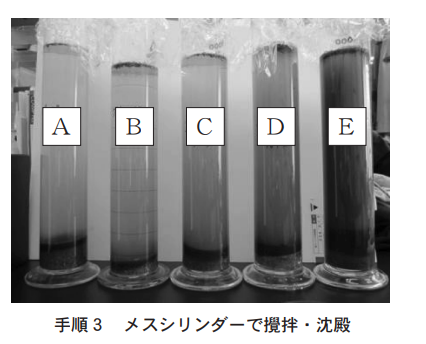
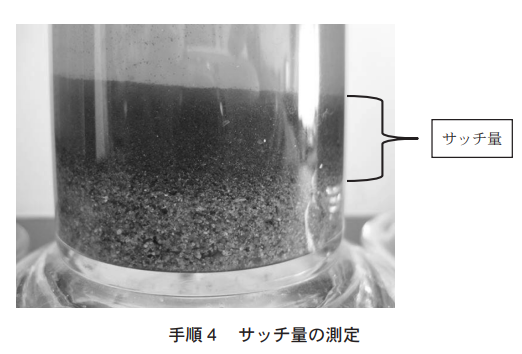
(2) Results and Discussion of Thatch Volume and Thatch Weight Measurements
As a result of continuous biannual treatments of CDU-containing fertilizer (Green Base NPK) and thatch degrading material (Bacillus subtilis) from 2013 to 2016, it can be said that the amount of thatch showed a clear decreasing trend compared to the no-application area. Although no significant difference was observed between GreenBase NPK and thatch decomposers, it is possible that the use of GreenBase NPK alone was as effective as thatch decomposers. However, it is highly likely that continuous application will lead to a reduction of thatch.
Although the method of measuring the amount of thatch described in this article is time-consuming and labor-intensive, the amount of thatch can be estimated to some extent even up to step 4 described above as a simple method of measurement. In particular, where measurements are made with a measuring cylinder, differences often appear in the time it takes for the water to precipitate. This is because it takes a long time for the water to become clear to a certain degree after finally precipitating in soils that are considered to have a large amount of thatch. The photo in step 3, taken about one hour after stirring, clearly shows that the no-treatment area remained turbid and took longer to settle than the other treatment areas. The large number of fine, undecomposed materials is thought to be the cause of the turbidity not resolving over a long period of time. The amount of thatch should be checked at least once a year, as the increase in these substances reduces the permeability and drainage of the soil.

4. Conclusion
The application of fertilizers containing CDU (Greenbase NPK) and thatch degrading materials (Bacillus subtilis) can be effective means to reduce thatch. However, since golf course management budgets are decreasing year by year, long-term continuous application may be difficult, but the effects of reducing thatch include: 1) prevention of disease outbreaks (less fungicide use), 2) reduction in the frequency of vertical cutting and the amount of sand applied, 3) reduction in the cost of materials to replace grass where it has died due to acidic soil, and 4) reduction in the cost of materials to neutralize acidic soil. (3) the cost of materials to replace dead lawns and neutralize acidic soils can be reduced, and (4) the effectiveness of herbicides can be prevented. Considering the additional cost of increased thatch, regular application of fertilizers such as CDU-containing fertilizers (green-based NPK) is not considered to be expensive.
